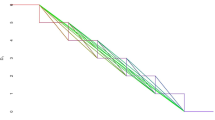Abstract
We propose an optimal pricing model for products with both positive and negative network effects. A closed-form expression of the optimal pricing policy is derived under the assumption that the demand function is linear. When there are two customer types with different attitudes towards congestion, the monotonicity of the optimal price differs according to the price sensitivity of each customer type. We show that even if the number of customers who are averse to congestion increases, if the negative-type price sensitivity is low and the positive network effect is weak, increasing the optimal price will increase total profit.


Similar content being viewed by others
Change history
09 September 2023
A Correction to this paper has been published: https://doi.org/10.1057/s41272-023-00441-x
References
Du, C., W.L. Cooper, and Z. Wang. 2016. Optimal pricing for a multinomial logit choice model with network effects. Operations Research 64 (2): 273–559.
Du, C., W.L. Cooper, and Z. Wang. 2018. Optimal worst-case pricing for a logit demand model with network effects. Operations Research Letters 46 (3): 345–351.
Hu, M., Z. Wang, and Y. Feng. 2020. Information disclosure and pricing policies for sales of network goods. Operations Research 68 (4): 965–1284.
Leibenstein, H. 1950. Bandwagon, snob, and Veblen effects in the theory of consumers’ demand. Quarterly Journal of Economics 64: 183–207.
Maldonado, F., G. Berbeglia, and P.V. Hentenryck. 2020. Pricing under a multinomial logit model with non linear network effects. Working paper, arXiv:2005.03352.
Navon, A., O. Shy, and J.F. Thisse. 1995. Product differentiation in the presence of positive and negative network effects. Center for Economic Policy Research, 1306.
Nosrat, F., W.L. Cooper, and Z. Wang. 2021. Pricing for a product with network effects and mixed logit demand. Naval Research Logistics 68 (2): 159–182.
Wang, R., and Z. Wang. 2017. Consumer choice models with endogenous network effects. Management Science 63 (11): 3944–3960.
Acknowledgements
This work was supported by a JSPS Grant-in-Aid for Scientific Research (C) (Grant No. 20K04976).
Author information
Authors and Affiliations
Corresponding author
Additional information
Publisher's Note
Springer Nature remains neutral with regard to jurisdictional claims in published maps and institutional affiliations.
The original online version of this article was revised: Modifications have been made in the Font size in the paragraph after equation 5 and before equation 11 and figures 1 and 2. Full information regarding the corrections made can be found in the correction for this article.
Rights and permissions
Springer Nature or its licensor (e.g. a society or other partner) holds exclusive rights to this article under a publishing agreement with the author(s) or other rightsholder(s); author self-archiving of the accepted manuscript version of this article is solely governed by the terms of such publishing agreement and applicable law.
About this article
Cite this article
Iwaji, N., Sato, K. Optimal pricing policy in the presence of positive and negative network effects. J Revenue Pricing Manag 23, 112–118 (2024). https://doi.org/10.1057/s41272-023-00437-7
Received:
Accepted:
Published:
Issue Date:
DOI: https://doi.org/10.1057/s41272-023-00437-7




